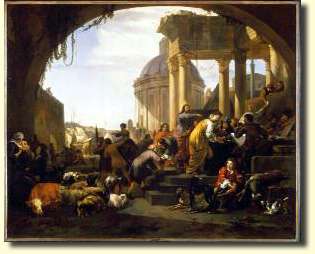Weenix Jan Baptist The Elder
(1621-1663) | Nationality: | Dutch |
| Activity: | Painter |
| Average rate: | Between $ 25,000 and 40,000 |

Claes Berghem end Jan Baptist Weenix
De roeping van Mattheus, ca. 1657
oil on panel 98,2 x 120,8 cm
J.B Weenix was the son of a well known architect and at the death of his father worked as an apprentice with a bookseller.
Unsatisfied he started to produce some drawings until he became the pupil of Jan Micker and of Abraham Bloemaert in Utrecht.
While in Amsterdam he received the advice of Nicolas Moeyaert and went to Italy in 1642. He remained four years in Rome under the protection of Cardinal Battista Pamphili who was to become Pope under the name of Innocent X. To honour his protector he notably adopted the name of Jan Baptist.
Back in Amsterdam around 1646 he went on to settle in Utrecht where he became commissioner of the Painters Guild in 1649 and befriended Van Poelenburgh and Jan Both.
Living in the castle of Huys-Terneyen he taught painting to his son Jan and to Melchior dHondecoeter, his wifes nephew.
Jan Baptist Weenix painted biblical scenes and landscapes a genre in which he excelled and in a style recalling that of Claude Gelle. he also produced market scenes and still lifes. Weenix painted landscapes with Roman ruins with a close attention to nature but he often produced artifical decors recreating fantasy scenes with numerous figures.
In less strange scenes as in the Roman landscapes with shepherds and their herds in the Kunstmuseum of Basel, he however succeeded in synthesing Dutch realism and that typical Italianate representation of the Roman countryside.
It remains that many of Weenixs paintings look mysterious and deserve to be analysed under a new light notably when one comes across the Couple in a Bark now in the Louvre Museum in which Weenix established a curious link between Claude Lorrain and Watteaus dreams towards evasion.